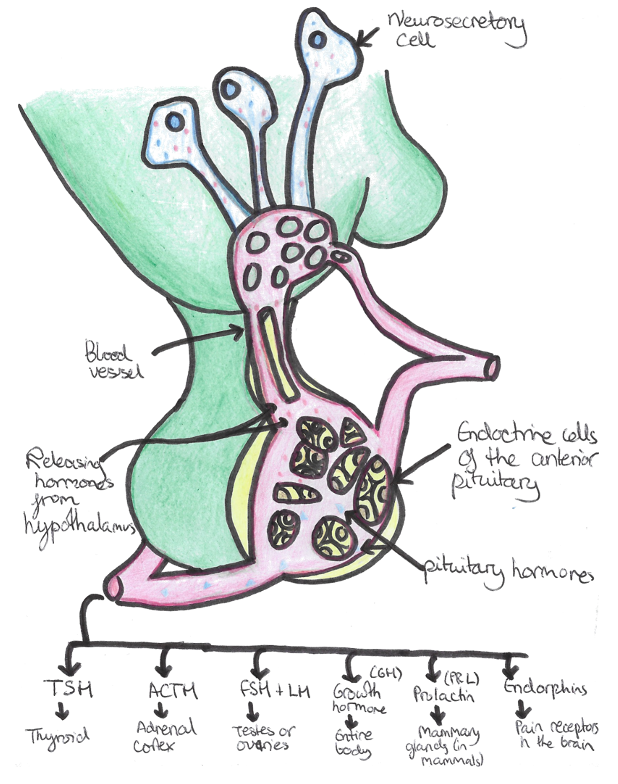The pituitary gland is one of the most important endocrine glands in the body. It interacts with the hypothalamus which stimulates the production of hormones from the pituitary. It is split into 2 parts:
Posterior pituitary
This is a down-growth of the brain contained within the blood brain barrier which releases 2 hormones:
a) ADH
This controls the water content on the body by influencing water reabsorption from collecting duct.
– Binds V1 receptors on artieroles (vasoconstriction) + V2 receptors on collecting duct
– N.B. Ethanol inhibits ADH secretion, explains why you need to urinate (“Break the seal”)
b) Oxytocin
This is responsible for the milk ejection reflex; acts in the mammary glands to release milk
– Uterine contractions; important for cervical dilation before
Anterior pituitary
This lies outside the blood brain barrier and is made up of hormone producing cells. It is stimulated by hormones released into the portal blood circulation and then it releases hormones into the blood stream.
i) TSH:
Thyroid stimulating hormone acts on thyroid gland resulting in release of T3 and T4
ii) ACTH:
This acts on adrenal cortex to cause release of glucocorticoids and mineralocorticoids.

iii) Prolactin:
Secretion is stimulated by PRF (prolactin releasing factor)
– Secretion is inhibited by tuberoinfundibular (TIDA) dopamine neurones
– Causes enlargement of mammary glands during pregnancy
– Stimulates mammary glands to produce milk and plays an important role in maternal behaviour.
– Contributes to pulmonary surfactant synthesis and neurogenesis
iv) FSH/LH:
These sex hormones act on the testes and ovaries
– This results in sexual maturation by forming testosterone and oestrogen.
– Regulated by GnRH secretion from the hypothalamus which is produced in quantities during puberty.
Males: FSH binds Sertoli cells whereas LH binds Leydig cells.
– In puberty, FSH stimulate primary spermatocytes to undergo meiosis, to form secondary spermatocytes.
– LH increases testosterone which responsible for secondary characteristics and sperm production.
Females: FSH initiates follicular growth whereas LH triggers ovulation.
v) Growth hormone
This is a hormone which is secreted by somatotrophs in response to hypoglycaemia, low free fatty acids and high amino acids.
– Secretion stimulated by GnRH produced by the hypothalamus
– Secretion inhibited by somatostatin produced by delta cells of pancreas – this inhibits GH and TSH from the pituitary and release of VIP + glucagon + insulin from pancreas.
It has many effects both on metabolism and growth:
Metabolic – Stimulates gluconeogenesis and lipolysis
– Reduces glucose uptake from fat and muscle raising blood [glucose]
– Increases protein synthesis and conversion of T4 –> T3
Growth – It acts by stimulating production of IGF-1 in the target tissues.
– It stimulates osteoblast and chondrocytes to promote bone growth.
– Insulin is a permissive factor – hence you do not grow in starvation.


